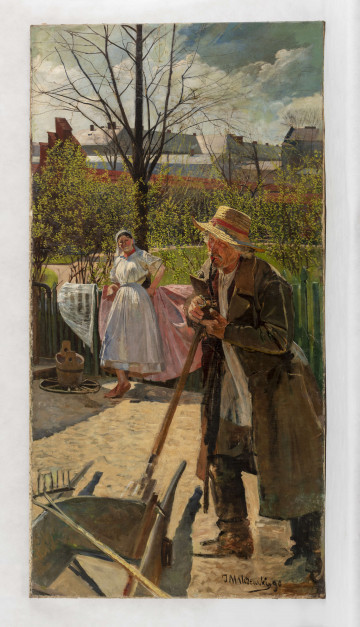
Spring has come again
1890
National Museum in Lublin
Part of the collection: Genre scenes (19th–1st half of the 20th c.) European painting of the 17th and 18th c.
In the great legacy of Teodor Axentowicz (1859-1938), two parallel thematic trends can be distinguished – portrait and genre painting. As a portraitist, he became famous for his sensual, charming and mysterious oil and pastel portraits of women. In the second trend, an important place was taken by the native folklore, multicoloured motifs from the Borderlands. Axentowicz was the first to introduce to Polish painting the Hutsul theme, which was very popular in the works of the next generation. Probably due to his origin, he also took up motifs connected with the history and culture of Polish Armenians.
The beginning of the genre trend in the artist's art dates to the early 1880s, the period of his studies in Munich. Based on sketches he had brought from the Hutsul region, from the area of Jamno and Kolomyia, he recreated episodes from the life of the village (for example, Pogrzeb na Rusi [Funeral in Rus], Gęsiarka [Goose Girl]). The motifs are taken from the rich culture of the Eastern Carpathian highlanders, holidays and religious rituals: blessing of thimbles, water and food, funerals, processions, games and images of Hutsuls, are permanent features of his works. For several decades he did countless such works, repeatedly transforming one theme in different approaches and techniques. The best-known painting is Święto Jordanu [Feast of the Jordan] (1893), a monumental religious scene in a winter setting conveying the austere mood of the ceremony. Seriousness and melancholy also characterise the small composition Dziewczyna ze starcem [Girl with an Old Man], which is associated with the above-mentioned work. Some generic elements suggest that the representation may also refer to the Feast of Our Lady of Thunder, celebrated in the Eastern Church on 15 February. The thunderbolt consecrated in the church was supposed to ensure good fortune and protect from charms.
The picture shows two poor figures walking across a snowy plain: in front, there is a Hutsul girl carrying a lighted candle; behind her, there is an old man in a red sheepskin coat, with a hat in his hand. This inconspicuous folklore scene, made with simple means, just a few cool colours, contains a certain ambiguity. It can be read as a metaphor for the stages of life. Although the girl seems to be the old man's guide, her absent gaze and melancholy indicate simultaneous being ‘here’ and ‘somewhere else’. This pair can be found in both large elaborate compositions and small portrait studies.
Bożena Kasperowicz
Author / creator
Dimensions
cały obiekt: height: 27,3 cm, width: 37,2 cm
Object type
painting
Technique
oil technique
Material
oil-based paint, cardboard
Creation time / dating
Creation / finding place
Owner
The National Museum in Lublin
Identification number
Location / status

1890
National Museum in Lublin
1911
National Museum in Lublin

around 1908
National Museum in Lublin
DISCOVER this TOPIC
National Museum in Lublin
DISCOVER this PATH
Educational path